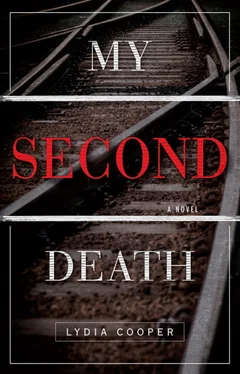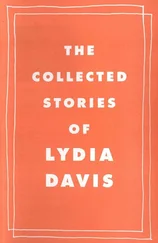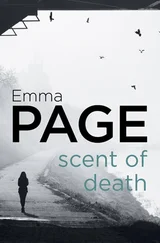“Look,” I say, “I’m not coming over. Today was kind of a — a long day.”
“But everything is — look, babe, I need you. I’ve got something to talk to you about.”
“No,” I say. “Not tonight.”
He sighs. I imagine him stubbing out the cigarette, the black and red scorch mark it leaves like an exhausted eye.
I don’t want to hear him try to convince me to come over. I don’t want to hear what he has to tell me. I hang up the phone and wonder where the cat has got to, if it will die of exposure or get hit by a car, and if either of those deaths is better than the quick clean slash of a knife blade.
When I wake up in the morning my hair smells like smoke, and the cotton pillowcase is gritty with fine ash.
I get up and trip on the yellow legal pad lying on my bedroom floor. Aidan’s notes. Because I don’t want to think about the smell of smoke or the house across the street, I sit down on the edge of the bed and read through them. His handwriting is as neat and evenly spaced as if he wrote in time to a metronome. I’ve noticed also that while he’s not particularly clean, he is often tidy, the sole exceptions being during moments of intense artistic creation when he will strew a room with paint and turpentine and the accoutrements of his art.
His mother’s name is at the top of the yellow paper: Barb Devorecek, 53, d. 06-23 . Below he has listed the names of his father and two sisters, and three additional names with the notation “former clients of B.D.” by them.
I stand up and go to the window. The burnt house is a ragged shell with black scorch marks on the sagging roof. Yellow crime tape is wrapped around the house like some Tim Burtonesque nightmare Christmas present. I don’t know what to do now. The county medical examiners have the charred remains of the body. Any evidence of handwriting is gone and after yesterday, after my first physical confrontation with Akron’s finest since I was ten years old, the last thing in the world that I want to do is draw more attention to myself by asking too many questions. They will investigate. And I will just watch the story unfold on CNN like every other American with a TV tray and a microwaved dinner.
My hands feel empty. I put my palms lightly on the cold glass and tell myself that the mystery is still there, that I still have a puzzle to solve. But I don’t. It’s been wrested from me by the same invisible hands that shoved me face first into it last week.
I hear the creak of the shower faucet and steady thrum of water against the fiberglass hull of the shower stall.
And realize I still have one more lead. I have my relentlessly disinterested roommate. It would be tidy if he were the killer. But he never looked at the house or brought up the subject of corpses without any hint that he enjoyed making them. He acted genuinely freaked out after the fire. And while he’s not stupid, he doesn’t seem as book-clever as I would expect a German-speaking Shakespeare-loving sadist to be. But what do I know. Solving people is not my forte.
The cold case.
I turn away from the window and grab my laptop, pull over the yellow legal pad, and hunt under my bed for a pen. I can solve Aidan, of course.
I get online and look up Aidan’s mother’s name and read through the initial news story — a local woman found dead in a house fire — and the obituary. According to the obit, Mrs. Devorecek worked part-time as a child therapist, often working from her home. A credit to the community, a loving wife and mother, she was survived by her former husband, her two daughters, and her son. A close friend of hers started a scholarship in her name for poor inner-city children to study music.
Grabbing a pen, I scan Aidan’s notes for the friend’s name but it doesn’t appear on the list. I jot it down: Judith Greene . Then I go back to the reports. A few months ago, the city reopened the case. It had been classified a homicide but no one was ever arrested. One of the children was present at the scene, an adult daughter named Stella. Unavailable for questioning — found in catatonic state — institutionalized. No viable leads.
…After a potential lead regarding the investigation into the unsolved death of Barbara Devorecek, a local woman found dead in a house fire ten years ago, Akron city police have re-opened the case.
But after the news update, there is no more information.
I chew on the end of my pen and think for a while.
Then I close my laptop, slide it and the legal pad into my backpack, and leave for work.
Because I taught yesterday, my schedule today is open. I have office hours and I need to research, but I have some time before I have to go to campus. I drive around for a bit, circling through the streets that carve dark gouges through the snow heaps and the grim cement and brick towers. Gusts of smoke from sewer grates pass like wraiths through the maze of downtown.
I pull over finally near one of the old churches, St. Bernard’s. An elegant gray stone building with soot-blackened saints keeping watch from the ornamental buttresses. A plastic laminated sign affixed to the front doors reads “Soup Kitchen Mondays Wednesdays Fridays at 11 A.M.”
I have driven by this church before and noticed the sign, but without much interest. Until now. I have to park on a steep sloping alley and I yank on the parking brake. I check my watch as I go up the steps of the church. It’s ten-thirty.
A few volunteers inside are setting up folding tables. I can tell they are volunteers because they wear nametags that read Volunteer.
“Hi, can I help you?”
A woman comes hustling over, her ponderous chest swaying under a thin beige sweater. She’s tying an apron around her waist as she comes.
I do intend to look into Aidan’s mother’s death, but it seems pointless not to at least try to find the homeless woman, my last shred of potential information about the corpse and his killer. Not that I expect much.
“I’m looking for someone,” I say. “A—” Shit, what’s the politically correct word for a homeless drug addict with mental problems? “A woman with a — ah, a Dora the Explorer backpack.”
“A what now?”
Her brows bunch over her eyes, gray hedges against the light in her irises. She is wearing tan slacks and a beige sweater, both wrinkled and faded, and threads of gray hairs cluster around her temples. But she has a piercing in one nostril and I think that at one point in her life she thought of herself as beautiful.
I know I need to explain what I need better, so I take a breath and start again.
“I ran into a woman — she wasn’t, she doesn’t have a home. It was pretty obvious.”
“You’re saying she was homeless.”
Oh, that one is easy. “Right. She’s homeless. She carries a Dora the Explorer backpack and she has symptoms of tardive dyskinesia.”
“Tardy what?”
“Not — look, she’s been on schizo meds. Lithium, Thorazine, you know, the stuff that makes you twitch like you’ve got St. Vitus’s Dance.”
“Saint Who? What are you talking about?”
“Come on,” I say. This is bullshit. She works with homeless people, she has to know what I’m talking about. I blink and pluck at my nose and move my tongue around my mouth, feeling my teeth, my lips.
The woman moves her head back, her eyebrows going up.
“Like that,” I say. “Do you know who I’m talking about?”
“Okay,” she says. “Yeah, that could be a lot of people. Is she a regular here?”
“I don’t know,” I say. “I’m looking for her. I think she saw something—”
“Whoa now, are you talking about, a crime? She’s wanted for questioning?”
“No, nothing like that,” I say. But I can’t think of another story to fill in the blank. “Not like that. I just want to — talk to her.”
Читать дальше












